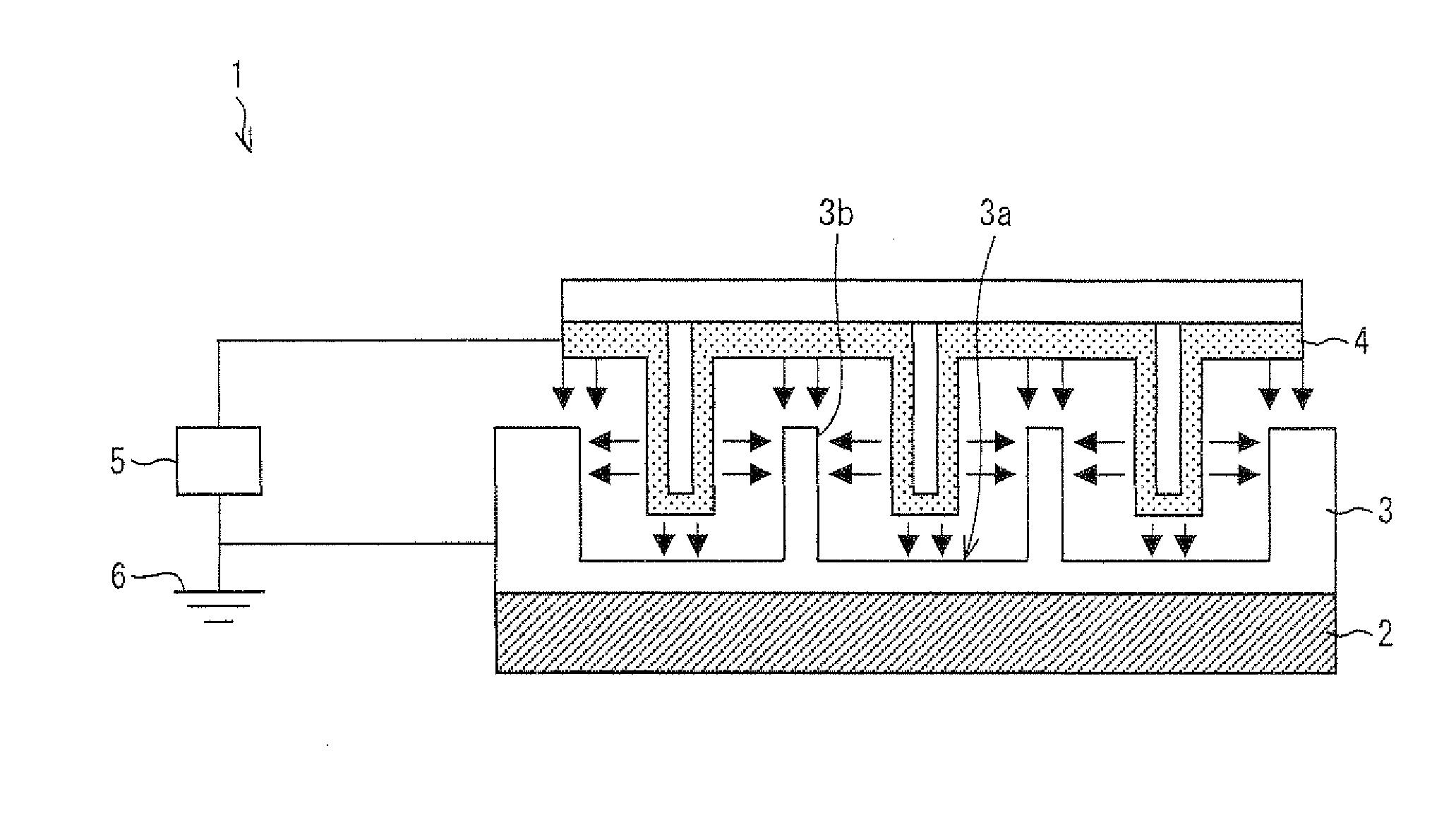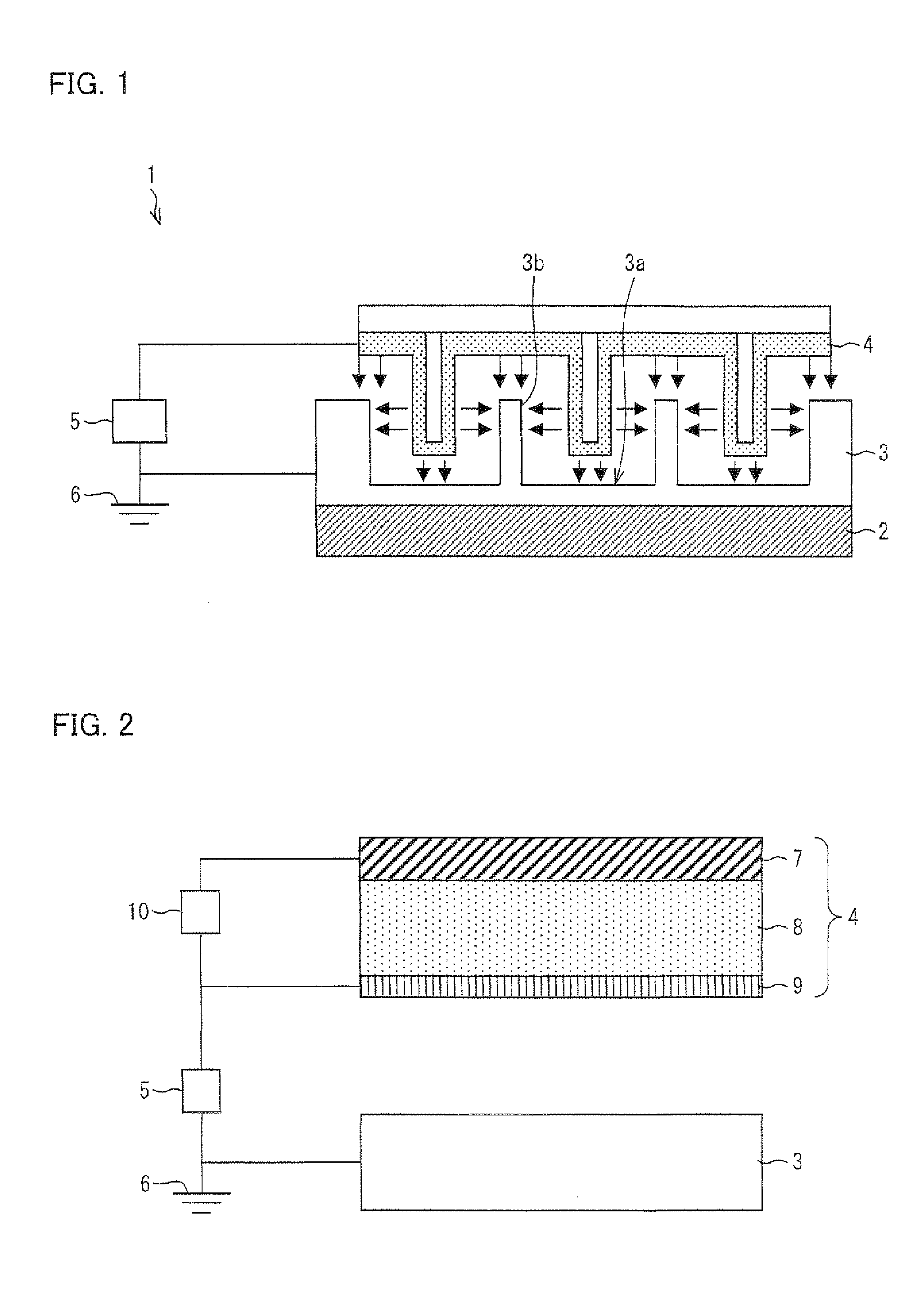Heat exchanger
a technology of heat exchanger and ion exchanger, which is applied in the direction of lighting, heating apparatus, and semiconductor/solid-state device details, etc., can solve the problems of large cooling device size, local temperature rise, and high voltage risk of cooling device using corona discharge, so as to reduce the distance between electrodes and the number of discharge sections , the effect of stabilizing the ionic wind
- Summary
- Abstract
- Description
- Claims
- Application Information
AI Technical Summary
Benefits of technology
Problems solved by technology
Method used
Image
Examples
embodiment 1
[0058]One embodiment of the present invention is described below with reference to FIGS. 1 through 9. Note that an arrangement described below is merely a specific example of the present invention. Thus, the present invention is not limited to this arrangement. FIG. 1 is a cross-sectional view illustrating a preferable example of a heat exchanger (cooling device) 1 according to the present embodiment.
[0059]The heat exchanger 1 is a device for releasing, to the outside, heat generated by a heating element (target of heat exchange) 2. The heat exchanger 1 includes: a heat sink (contact member) 3; an electron emitting element 4; and a power supply (second voltage applying means) 5. The heat sink 3, which is made of a conductive material, is in contact with the heating element 2. The heat sink 3 has a surface 3a opposite from the heating element 2 which surface is in contact with air. The heat sink 3 includes a plurality of convexities 3b formed at least partially along the surface. The...
example 1
[0079]With reference to FIGS. 5 and 6, the following describes, as an example, experiments for verifying the heat dissipation effect achieved by the heat exchanger according to the present invention. Note that these experiments merely serve as example embodiments, and that the description of the experiments does not limit the scope of the present invention.
[0080]The experiments of the present example were conducted with use of a heat exchanger illustrated in FIG. 5. The heat exchanger illustrated in FIG. 5 was equipped with a fan 14 (airflow generator) so that the fan would blow air toward the heat sink 3. The heating element 2 serving as the heat source was arranged to start or stop generating heat in response to an on-off action of a switch. When the switch was turned off, the heating element would stop generating heat. In the present example, the heat generation by the heating element 2 was stopped (i.e., the switch was turned off) simultaneously with a start of temperature measu...
embodiment 2
[0085]Another embodiment of the present invention is described below with reference to FIG. 7.
[0086]A heat exchanger of the present embodiment has an arrangement and a drive principle which are basically identical to those of the heat exchanger according to Embodiment 1. Such identical parts of the arrangement and the drive principle are not described here. The heat exchanger of the present embodiment differs from the heat exchanger of Embodiment 1 in how the electron emitting element is arranged. FIG. 7 is a view illustrating the arrangement of the electron emitting element and its surroundings of the heat exchanger according to the present embodiment.
[0087]As illustrated in FIG. 7, the electron emitting element 16 is characterized by its flexibility. The electron emitting element 16 includes: a flexible substrate 18; a substrate thin-film electrode 17; the electron acceleration layer 8; and the thin-film electrode 9. The substrate thin-film electrode 17 and the thin-film electrode...
PUM
| Property | Measurement | Unit |
|---|---|---|
| diameter | aaaaa | aaaaa |
| diameter | aaaaa | aaaaa |
| thickness | aaaaa | aaaaa |
Abstract
Description
Claims
Application Information
 Login to View More
Login to View More - R&D
- Intellectual Property
- Life Sciences
- Materials
- Tech Scout
- Unparalleled Data Quality
- Higher Quality Content
- 60% Fewer Hallucinations
Browse by: Latest US Patents, China's latest patents, Technical Efficacy Thesaurus, Application Domain, Technology Topic, Popular Technical Reports.
© 2025 PatSnap. All rights reserved.Legal|Privacy policy|Modern Slavery Act Transparency Statement|Sitemap|About US| Contact US: help@patsnap.com



